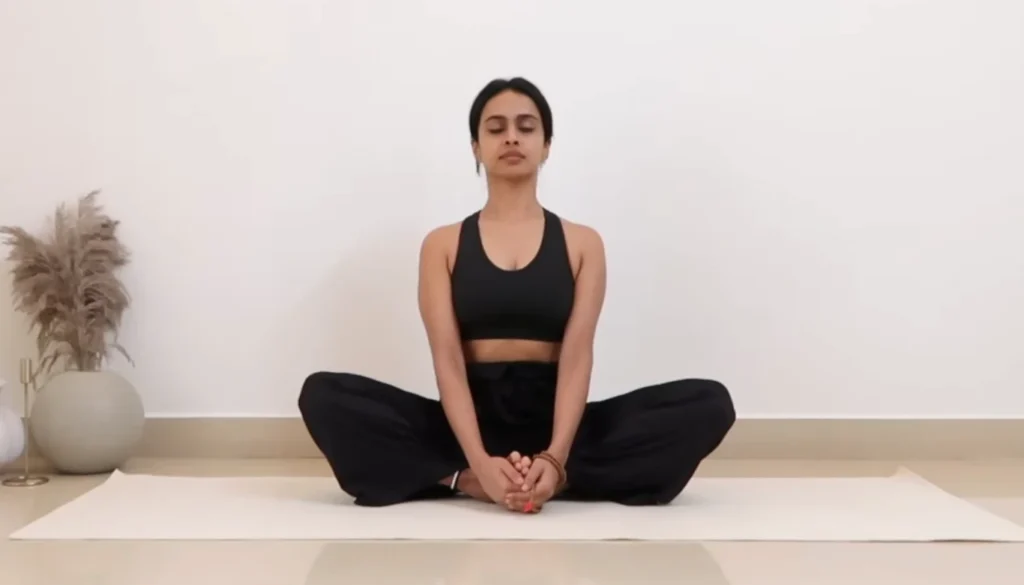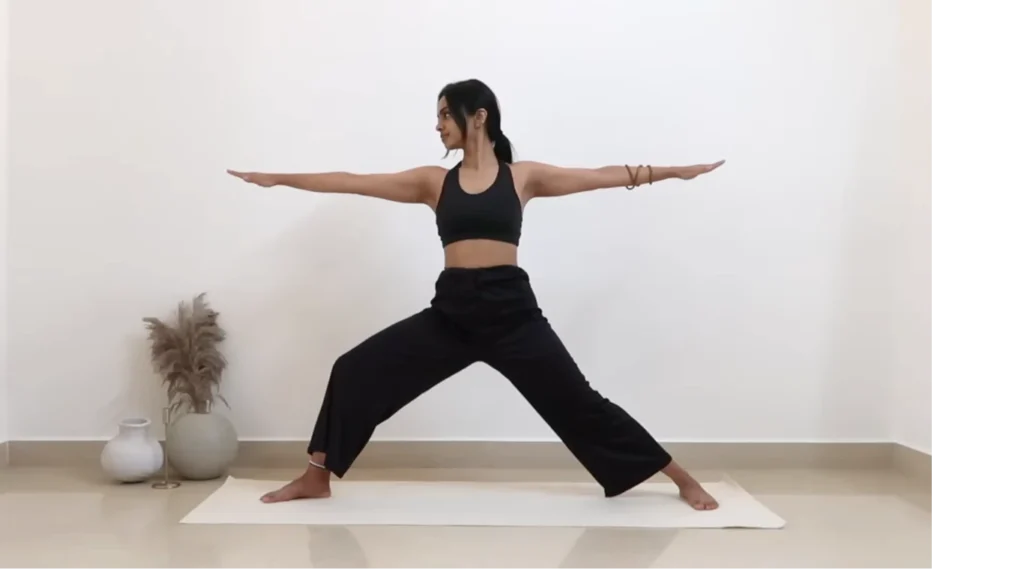Both Hatha and Vinyasa yoga are wonderful, and I love teaching them to my students. Hatha yoga is slow and calm. You hold each pose for a while, focus on your breath, and find stillness. I recommend it to people who want to relax or are new to yoga. And it also use for weight loss. For example, Lucas was going through a tough time and found Hatha yoga helpful to calm his mind and feel grounded.
Vinyasa yoga is more about movement. You flow from one pose to the next, connecting each movement with your breath. It’s great when you want a more active practice that builds strength and flexibility. Henry, another student, was feeling low on energy, and after practicing Vinyasa for a few weeks, she felt much more energized and connected to her body.
When I teach, I think about what we need that day. Sometimes we want the calm of Hatha, and other times, we need the energy of Vinyasa. Both styles offer so much, and I love helping my students find what feels best for them.

What is Hatha Yoga?
Hatha Yoga is one of the oldest and most traditional forms of yoga. It focuses on holding simple poses and breathing deeply. This style is great for beginners because it moves slowly and gives you time to learn the basics of how to align your body and control your breath. In Hatha Yoga, you hold poses for longer periods, which helps you build strength and flexibility. Many people use Hatha Yoga as a way to prepare their body for meditation and other spiritual practices.
Hatha Yoga has been around for more than 1,000 years. It was first taught in ancient India as a way to prepare the body for deep meditation. The word “Hatha” comes from the Sanskrit words “Ha” meaning sun and “Tha” meaning moon, symbolizing balance and harmony.
A 2019 survey by Yoga Alliance showed that Hatha Yoga is one of the most practiced types of yoga, especially by beginners. It’s popular because it’s easy to learn and provides great health benefits like stress relief, improved flexibility, and strength.
What Are The Benefits Of Hatha Yoga?

1. Improves Flexibility
Regular practice of Hatha Yoga involves stretching muscles, which enhances flexibility and reduces stiffness. According to research published in PMC (PubMed Central), improving your range of motion can help prevent injuries and promote overall mobility (PMC).
2. Builds Strength
Holding various poses in Hatha Yoga strengthens muscles, particularly in the core, arms, and legs. Wiley Online Library emphasizes that strengthening these muscle groups supports joint health and improves posture (Wiley Online).
3. Reduces Stress
The slow pace and focus on deep breathing in Hatha Yoga help calm the mind, reducing stress and anxiety. A study in PMC found that this practice promotes relaxation and mindfulness, significantly improving mental health (PMC).
4. Improves Balance
Many Hatha Yoga poses require balancing on one foot or holding positions for extended periods. According to a PMC article, these practices enhance overall balance and coordination, which are essential for daily activities and fall prevention (PMC).
5. Boosts Mental Clarity
The emphasis on deep breathing and mindful movements in Hatha Yoga helps clear the mind, improve concentration, and reduce mental fatigue. Brain Plasticity highlights that these practices can enhance cognitive function and overall well-being (Brain Plasticity).
6. Enhances Posture
As you become stronger and more aware of your body through Hatha Yoga, your posture naturally improves. According to govinfo.gov, good posture helps prevent back pain and contributes to overall better health (govinfo.gov).
7. Prepares for Meditation
Hatha Yoga is often used to prepare the body for meditation. The physical practice helps you relax and become more focused when sitting still. According to govinfo.gov, this prepares you for deeper meditative experiences (govinfo.gov).
8. Improves Breathing
Hatha Yoga teaches you to breathe deeply and with control, improving lung capacity and overall breathing. Research from govinfo.gov highlights how better breath control supports better oxygenation of the body and promotes relaxation (govinfo.gov).

What is Vinyasa Yoga?
Vinyasa Yoga is a fast-paced and flowing type of yoga. It links each movement to your breath, so one pose smoothly flows into the next. Unlike Hatha Yoga, Vinyasa is quicker and more energetic, making it a good choice if you want a workout that gets your heart pumping. The sequences of poses change from class to class, so each session is different and fun. Vinyasa helps you become stronger, more flexible, and improve your endurance, all while focusing your mind.
Vinyasa Yoga comes from the traditional practices of Hatha Yoga. The word “Vinyasa” means “arranging in a special way” in Sanskrit. It became more popular in the 20th century, especially thanks to teachers like T. Krishnamacharya and K. Pattabhi Jois, who helped spread it worldwide. It’s often called “flow yoga” because of the continuous flow between poses.
Studies show that Vinyasa Yoga not only helps improve strength and flexibility but also reduces stress and anxiety, making it good for both your body and mind.
What Are The Benefits of Vinyasa Yoga?

1. Improves Strength
Vinyasa Yoga involves transitioning between poses in a continuous flow, which helps build strength, particularly in the core, arms, and legs. According to a study published by Wiley Online Library, strengthening these areas supports overall muscle function and stability (Wiley Online).
2. Increases Flexibility
The fluid movements in Vinyasa Yoga help stretch your muscles, improving flexibility and making your body more relaxed. A study in PMC found that regular Vinyasa practice leads to significant improvements in flexibility and range of motion (PMC).
3. Boosts Cardiovascular Health
Vinyasa Yoga’s faster pace increases the heart rate, providing a great cardiovascular workout. According to American Heart Association research, regular Vinyasa Yoga practice can help improve heart health and increase stamina (American Heart Association).
4. Reduces Stress
The emphasis on synchronized breath and movement in Vinyasa Yoga can calm the mind and reduce stress. Research published in PMC shows that yoga, especially Vinyasa, significantly decreases anxiety and stress levels by promoting relaxation and mindfulness (PMC).
5. Improves Focus and Mental Clarity
Vinyasa Yoga requires concentration on breath and movement, which improves mental clarity and focus. Studies in Brain Plasticity suggest that this kind of mindfulness and focus enhances cognitive function and helps sharpen your concentration in daily activities (Brain Plasticity).
6. Builds Endurance
Because Vinyasa involves continuous movement from one pose to another, it gradually increases physical endurance. Wiley Online Library found that the continuous nature of Vinyasa helps improve stamina over time, which is beneficial for overall physical health (Wiley Online).
7. Promotes Better Posture
The strength and flexibility developed in Vinyasa Yoga contribute to better posture, reducing the risk of back and neck pain. According to govinfo.gov, maintaining good posture helps prevent muscle strain and supports spine health (govinfo.gov).
8. Detoxifies the Body
Vinyasa Yoga promotes sweating, which helps flush out toxins from the body. A study in PMC highlights that the movement and perspiration involved in Vinyasa aid in detoxification, leaving you feeling energized and refreshed (PMC).
Biggest Difference Between hatha and vinyasa
| Aspect | Hatha Yoga | Vinyasa Yoga |
|---|---|---|
| Pace | Slower-paced, more relaxed | Faster-paced, dynamic and flowing |
| Focus | Holding static poses, alignment, deep breathing | Fluid movement with breath, continuous sequences |
| Intensity | Less intense, calming | More intense, energetic |
| Duration of Poses | Poses held for a longer period | Poses held for a shorter time |
| Mental Focus | Encourages mindfulness and mental calmness | Focuses on synchronizing breath with movement |
| Physical Challenge | Less physically demanding, good for beginners | More physically challenging, full-body workout |
| Best For | Beginners, relaxation, stress relief | Building strength, endurance, cardiovascular fitness |
Which one is the best option for you?
Choose Hatha Yoga if:
- You are a beginner.
- You want a calm and relaxing practice.
- You prefer a gentle workout.
- You want to improve flexibility.
Choose Vinyasa Yoga if:
- You want a dynamic and energetic workout.
- You want to build strength and endurance.
- You like variety in your practice.
- You prefer a faster pace.
Conclusion
Hatha and Vinyasa yoga offer unique benefits. Hatha yoga is great for beginners who want a slower, more relaxing practice to improve flexibility and learn the basics. On the other hand, Vinyasa yoga is perfect if you’re looking for a faster, more energetic workout that builds strength and endurance. The choice depends on your goals and what kind of practice you enjoy. Whether you choose Hatha or Vinyasa, both can help you feel better physically and mentally.
FAQ’S
What is the difference between Hatha Yoga and Vinyasa Yoga?
Hatha Yoga is slower-paced and focuses on holding poses for longer, making it ideal for beginners. According to Yoga Journal, it provides a strong foundation for learning alignment and breathing techniques.
Vinyasa Yoga is faster-paced and involves flowing from one pose to another. A study in the Journal of Bodywork and Movement Therapies shows that it improves cardiovascular fitness due to its high-intensity movements.
Which one is better for beginners?
Hatha Yoga is recommended for beginners as it allows more time to learn the basics of alignment and breathing. Yoga Alliance (2016) reports it as the most popular starting point for newcomers.
Vinyasa Yoga can be more challenging for beginners due to its faster pace, but it becomes suitable as you build strength and flexibility.
Can Vinyasa Yoga improve my cardiovascular health?
Vinyasa Yoga provides a cardiovascular workout due to its continuous movements. Research from the National Institutes of Health (NIH) supports its role in improving heart health, as it raises heart rate and boosts stamina.
Does Hatha Yoga help with flexibility?
Hatha Yoga is highly effective for improving flexibility. A 2017 study in the Journal of Alternative and Complementary Medicine found that it significantly increased flexibility in the spine, hamstrings, and hips over time.
How often should I practice Vinyasa or Hatha Yoga?
Hatha Yoga is recommended 2-3 times per week for building strength and flexibility, according to Yoga Alliance.
Vinyasa Yoga can be practiced 3-4 times a week to improve cardiovascular health, as suggested by a study in the Journal of Strength and Conditioning Research.


No responses yet